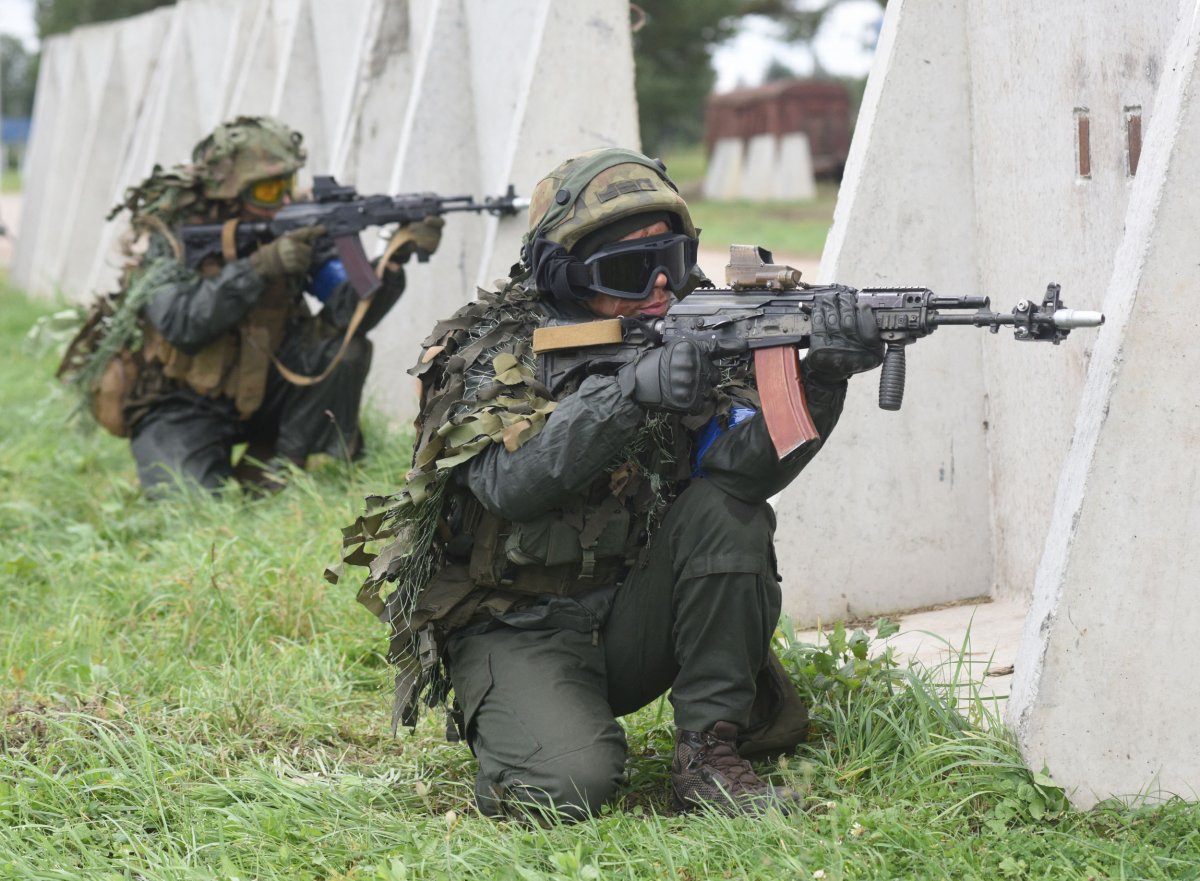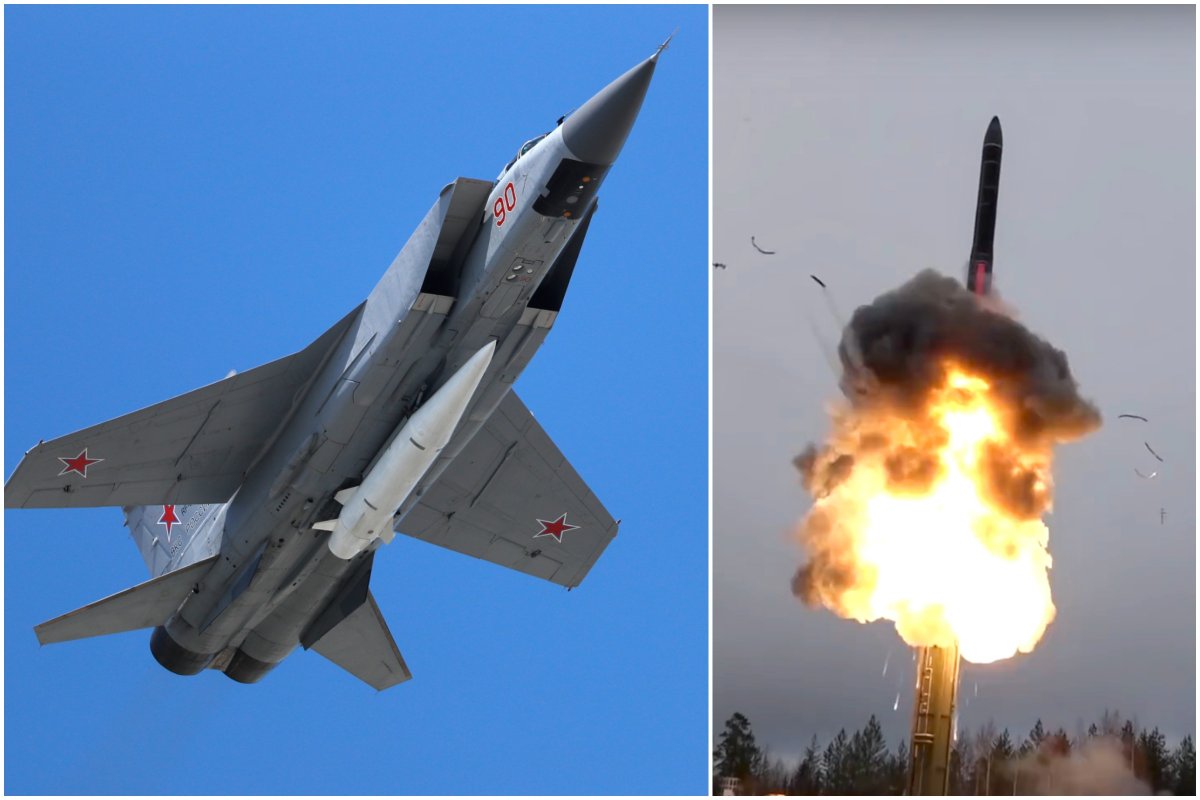In half boast, half warning, Vladimir Putin's comment Russia will have a sea-based hypersonic missile in service in 2022 was a full-throated signal to the west, especially when he said any NATO deployment to Ukraine would cross a "red line."
The latest testing of Russia's Tsirkon 3M22 missile this week coincides with the build-up of tens of thousands of Russian troops by Ukraine's border, amid fears an assault by Moscow is more likely than in April when it last massed its troops there.
Ever decrying an encroachment on Russia's own borders by the alliance, Putin told an investment forum this week if the flight time from Ukraine to Moscow was five minutes "in the case of a hypersonic weapon being deployed," his country could respond in kind.
"We can do that now," Putin said, suggesting that Russia had stolen a march on the U.S. and the west in the race for hypersonic missiles, which are faster and more agile than standard ones and so, present more difficulties for missile defense systems.
Gen. David Thompson, vice chief of space operations, sounded the alarm last month that the U.S. was "not as advanced" as the Russians, or the Chinese "in terms of hypersonic programs," Politico reported.
At Mach 9, the Tsirkon missile is at the low end of the hypersonic spectrum and has been launched several times since January 2020 from the Northern Fleet's Admiral Gorshkov. Moscow says it can hit targets at a range of up to 1,000 kilometers (660 miles).
"Assuming that the weapon is dual-use, that is both conventional and nuclear-capable, I think it changes the nuclear balance versus the United States," said Brent M. Eastwood, Defense and National Security Editor for Washington, DC foreign policy magazine 1945.
"As an anti-ship missile, it might overwhelm the American Aegis Combat System," he told Newsweek.

"Aegis needs eight to ten seconds of reaction time to intercept incoming missiles. However, in that time, the Tsirkon will have already traveled at least 12 miles," he said, "and we must worry that Tsirkon could have an accidental launch that could spark a nuclear exchange.
"It's an intriguing weapon for the Russians that shows their missile development prowess and ability for it to be used as a propaganda talking point for Putin."
Developed by the rocket design bureau Mashinostroyeniya NPO, the Tsirkon was not even among the five nuclear capability weapons programs in development, dubbed "super weapons" which Putin revealed to lawmakers at Russia's Federal Assembly in March 2018.
Four of those, the Sarmat, Avangard, Poseidon and Burevestnik, are strategic systems in that they are all long-range weapons, with a range greater than 5,000 km (3,100 miles). The Kinzhal, is a sub-strategic system with a range less than that.
However, over the last few months, state-run media has made much of successful launches of the Tsirkon, although there is doubt among experts over whether it has reached the 1,000 kilometer (660 mile) range Moscow has claimed.
The Tsirkon, unlike the pure hypersonic missiles which rely on scramjets, has also required a degree of ingenuity as it combines existing technologies.

It is thought to consist of a solid fuel booster to take the missile from launch to high altitude from where it follows a semi-ballistic 'skip-glide' trajectory towards its target. A detachable warhead is used to destroy the target when it is in range.
"It would appear they are a hybrid cruise missile and ballistic missile," said Richard Connolly, director of the Eastern Advisory Group consultancy, "it is a lower tech approach but it is innovative and you still get to the same destination."
"The U.S has done a lot of testing the purer hypersonic jets and coming up with all sorts of obstacles," he told Newsweek.
"What the Russians have done is cut the corner and said 'let's abandon the idea of trying to out compete with China and the U.S. with a pure system with a scramjet and instead use a hybrid technology."
"I can't see anything that suggests that Tsirkon is doing things that the U.S. can't do, they have just chosen to take another route." However, he believes that Russia has "moved ahead a little" in its missile development, "but not as much as they would like you to think."
In October, Russia said that it had successfully test-fired the missile from its Severodvinsk submarine in the Barents Sea for the first time. If confirmed, this could change military capability calculus because submarines can launch long-range rapid strikes from hidden locations underwater.
But Connolly, who co-wrote an assessment of Russia's military capabilities in analysis by the Chatham House think tank, said it appears that the launches were unsuccessful.
Meanwhile, last month Russia's defence ministry suggested there was more to be done. It said further Tsirkon tests would resume from the Project 885M (Yasen-M) modified nuclear-powered submarine Perm 2024, and "will differ from its predecessors by a slightly altered design," news agency Tass reported.
There has been progress in testing of the intercontinental ballistic missile (ICBM) the Sarmat, the Avangard missile system and the Kinzhal, in which Iskander ground-launched ballistic missiles are launched by the MiG-31K missile carrier.

However, the programs mentioned by Putin in 2018 have faced other hiccups. The Burevestnik, which NATO calls the SSC-X-9 Skyfall, is believed to have crashed during secret engine tests in Russia's Arctic in August 2019.
Also, missile capability also includes being able to identify and track a target, and for Russia this battle network that links sensors remains undeveloped.
"Several years ago, folks talked about how the United States was perhaps behind in terms of advanced missile testing and perhaps in development as well," said Tom Karako, senior fellow at the Center for Strategic and International Studies (CSIS), "having said that, the United States is moving out with all deliberate speed on a number of programs."
He pointed to the U.S. Air Forces Hypersonic Attack Cruise Missile (HCAM) and the U.S. Army's Long-Range Hypersonic Weapon (LRHW) being co-developed with the U.S. Navy.
General John Hyten, the second most senior US general told CNN last month that China's hypersonic missile test shows Beijing could launch a surprise nuclear attack on the United States.

But Karako said that amid the claims made by Russia and China, the U.S. "is evolving its own air defences to counteract these fundamentally aerial threats."
"I suspect in time the United States will be working with its allies in adapting to these threats not merely in terms of posture—how we are in radar forces to make it harder to be targeted, but also in terms of active defence as well."
Whatever stage of their development, Russia's hypersonic missile programs will be leverage in talks over a successor to the New START nuclear Treaty which has been extended to 2026.
Even if experts may think his claims about his country's military capabilities are mere bluster, Putin's threats are taken seriously by politicians —at least in public, as leaders grapple with what to do about the Russian build-up next to Ukraine.
"We are seeing the big puffer fish trying to see off its potential threats by expanding its size," said Connolly, "hence the not very subtle link between what is going on Ukraine."
Uncommon Knowledge
Newsweek is committed to challenging conventional wisdom and finding connections in the search for common ground.
Newsweek is committed to challenging conventional wisdom and finding connections in the search for common ground.
About the writer
Brendan Cole is a Newsweek Senior News Reporter based in London, UK. His focus is Russia and Ukraine, in particular ... Read more
To read how Newsweek uses AI as a newsroom tool, Click here.








